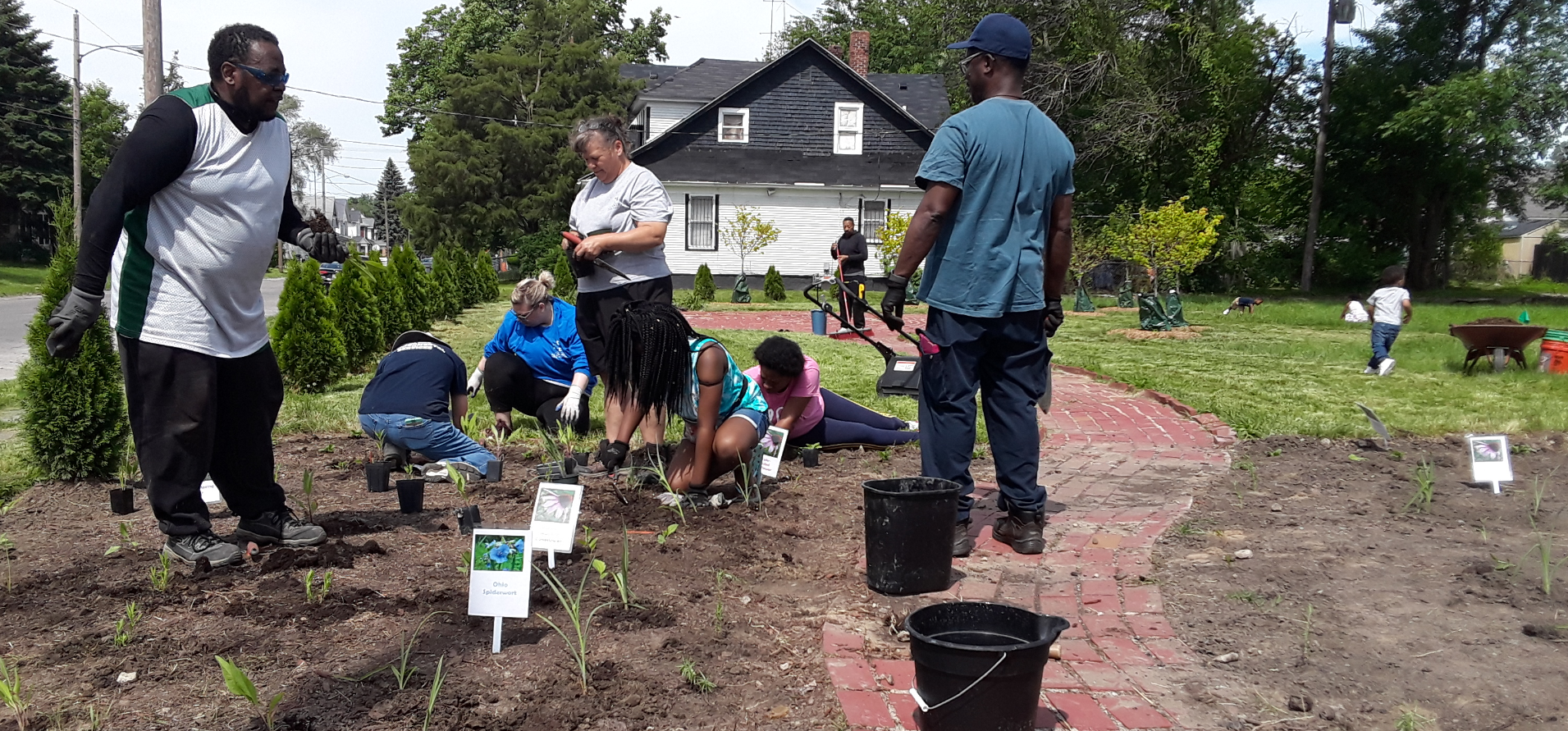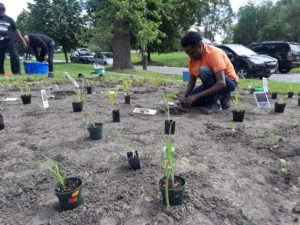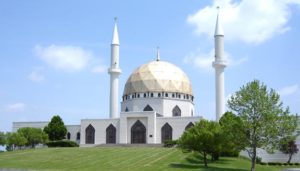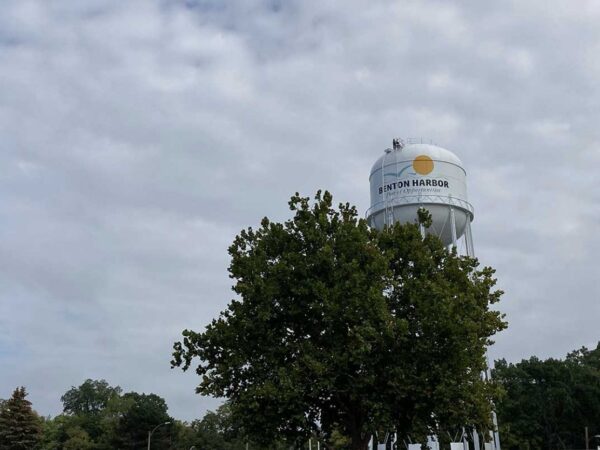
In a small Toledo neighborhood, there’s a building—the Glass City Church of Christ—that features a vibrant new rain garden running parallel to one of its walls.
It was a project that happened with the help and funding of the National Wildlife Federation’s Sacred Grounds program.
Rain gardens, as implied in the name, are designed to absorb rainwater runoff, which helps mitigate flooding, filter runoff and provide shelter for wildlife.
The rain garden has been transformative for the church, according to Beatrice Miringu, the sustainability coordinator for the city of Toledo, who connected with NWF once they found out about Sacred Grounds.
“Their sump pump was basically running every day all year,” she said. The road beside the church is still stained from the massive amount of rainwater that was constantly being drained onto the street.
But the sump pump wasn’t running on June 8. The rain garden was full, and a handful of birds were flitting around between the plants.
Sacred Grounds started as a pilot in Toledo
About a year and a half ago, the NWF started its Sacred Grounds program, which funds projects at houses of worship to install gardens within their communities.
“The central sort of piece of the program is really installing wildlife habitats or gardens onsite at the houses of worship, and our role is really to help people to see their vision come to fruition,” said Manja Holland, the regional education manager at the NWF’s Great Lakes Regional Center.
What that vision is depends on the group, whether it’s creating a safe space in the community or helping to contribute to improving water quality.
“The bugs need it, the butterflies need it,” said Cindy Carnicom, who works for the Olander Park System and is the owner of native plant nursery Poppin Up Natives. Carnicom has been providing the native plants for the Sacred Grounds participants in Toledo.
“It’s all part of the ecosystem,” she said, “but it also adds important impacts to us. It helps remove nutrients before it gets to the lake. It sucks up our CO2 and gives us oxygen. All of these things are tremendous. This is a great way to add a little bit of nature back.”
Lawns typically have a root depth of about 2 or 3 inches while native vegetation often have much deeper root systems, some of them going as far as 8 or 10 feet deep.
With the Maumee River opening into Lake Erie through Toledo, adding more native plants can have a big impact on what’s going into the lake.
Prayer park used to be a drug house

Beatrice Miringu, Sustainability Coordinator for the City of Toledo gardening in Prayer Park, Photo by Natasha Blakely
It was a bright and sunny day, perfect weather for planting a garden and then having a cookout.
Which is why that was the plan for the People’s Missionary Baptist Church in Toledo, Ohio, in early June.
A few handfuls of members from the church gathered at the lot a few blocks down from the church where the church was building a prayer park.
“We wanted to rebuild this community,” said Mike Key, pastor from People’s Missionary Baptist Church. “We noticed there was a lot of vacant land, a lot of run-down property, so that’s where we wanted to start, with the land, to rebuild a community and to cause people to come out of their homes and take pride in the neighborhood.”
The brick pathway was already laid, the benches were bought and waiting to be installed and the goal for the day was to plant all the young native plants the church had bought with the help of some funding from the Sacred Grounds program.
The land the prayer park was built on used to be a drug house, according to Key. The church partnered with the Lucas County Land Bank to turn the property into a prayer park. It also has four lots nearby that church members plan on turning into a picnic area for the neighborhood.
“I’m really hoping that all of this unused property, overgrown property will become a sanctuary place and a place that will change the whole complexion of the neighborhood,” Key said.
Houses of worship are ‘central hubs to communities’
The NWF started by holding workshops to get word out about the program and then took applications from interested houses of worship. There are currently 11 houses of worship in Toledo in the Sacred Grounds program, each receiving $1,500 for their projects.
The program is expanding to Detroit and Grand Rapids, with about 12 sites in Detroit and 20 in Grand Rapids taking part over the next two years.
Houses of worship were chosen as the focus because of their role as “central hubs to communities,” Holland said.
“It’s really important because we know that most people in the city don’t necessarily get involved in wildlife protection, so this was an opportunity to reach a different audience, working with the church, with houses of worship,” Miringu said. “That way we are meeting people where they are, we are meeting them at the places that they go to, and we’re just bringing the message to them in their own community.”
The broad term “houses of worship” serves a purpose as well. It isn’t just churches that the NWF is engaging with, but mosques and temples as well.
“It’s actually pretty diverse,” Holland said. “We have representation from a lot of Christian faith denominations. We also have a Hindu temple that’s just joined. There’s a mosque that’s involved as well. So one of our goals is really to try to engage diverse faiths in the program, and we’re also really interested in engaging racially diverse and socioeconomically diverse populations as well.”
The Islamic Center of Greater Toledo, located in Perrysburg, is one of the houses of worship involved in the Sacred Grounds program, but the Islamic Center’s green space efforts have been going on for decades.
The mosque sits on about 44 acres of land, with 39 of those acres rented to farmers and 5 used for buildings, parking and green space. Roughly 25 years ago, the mowing became such a big job that half the green space was converted into wildflowers, with seeds bought from the state of Ohio, said Emmett Kadri, a member of the mosque.
Years later, the mosque planted a garden to grow food for food banks, but after about three or four years there weren’t enough volunteers to maintain it so the land was returned to natural habitat.
“So when they introduced the Sacred Grounds project, we thought our area would be perfect for that,” Kadri said.
Besides providing funding for native plants in the mosque’s green space, the NWF has held workshops at the mosque as well for members to learn more.
“I’m a city boy, I’m not a farmer,” Kadri said. “The planting I do is some tomatoes. But it was interesting and they opened my eyes to it.”
“Sacred grounds for us, they’ve made us aware of the environmental impact that we can provide,” he added. “That to me is the main thing they’ve made us aware of.”
Featured Image: People’s Missionary Baptist Church parishioners gardening in Prayer Park, Photo by Natasha Blakely







